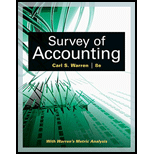
Concept explainers
Concept Introduction:
The
Requirement-1:
To Indicate:
If it is permissible to record additional
Concept Introduction:
The Balance sheet is a summary of Assets, Liabilities and equity accounts that reports the financial position of the business as on a specific date. Assets are further classifies into Current Assets, Long Term Investments, Plant Assets and Intangible assets. And Liabilities are further classified into Current Liabilities and Long term liabilities.
Requirement-1:
To Indicate:
If it is permissible to record additional depreciation if the asset is useful
Concept Introduction:
The Balance sheet is a summary of Assets, Liabilities and equity accounts that reports the financial position of the business as on a specific date. Assets are further classifies into Current Assets, Long Term Investments, Plant Assets and Intangible assets. And Liabilities are further classified into Current Liabilities and Long term liabilities.
Requirement-2:
To Indicate:
The time when the cost and the
Want to see the full answer?
Check out a sample textbook solution
Chapter 7 Solutions
Survey of Accounting (Accounting I)
 Intermediate Accounting: Reporting And AnalysisAccountingISBN:9781337788281Author:James M. Wahlen, Jefferson P. Jones, Donald PagachPublisher:Cengage Learning
Intermediate Accounting: Reporting And AnalysisAccountingISBN:9781337788281Author:James M. Wahlen, Jefferson P. Jones, Donald PagachPublisher:Cengage Learning Cornerstones of Financial AccountingAccountingISBN:9781337690881Author:Jay Rich, Jeff JonesPublisher:Cengage Learning
Cornerstones of Financial AccountingAccountingISBN:9781337690881Author:Jay Rich, Jeff JonesPublisher:Cengage Learning

